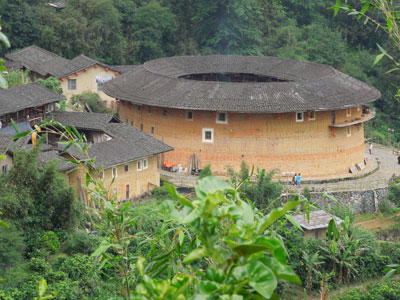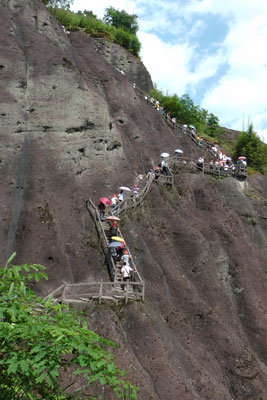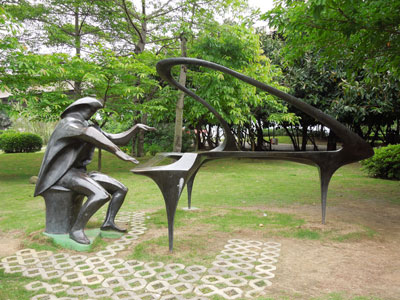Finding traditional China in the lovely coastal province of Fujian
This article appears on page 6 of the April 2013 issue.
by Jo Ann Mayer; Miami, FL
As travelers flock to China, both Starbucks and KFC are appearing on every corner in the large cities and it is becoming more challenging to discover a China not overrun by tourists. If you want to experience China, and not a touristy Chinatown, explore Fujian.
Fujian is a relatively small coastal province located in southeast China. With approximately 80% of the province covered in mountainous terrain and the East China Sea embracing the entire eastern border, Fujian offers a broad range of scenery. Being so close to Taiwan (it actually faces Taiwan across the Taiwan Strait), Fujian benefits from Taiwanese investment, apparent in its well-developed infrastructure.
Xiamen
My May ’12 trip with a small group of six other friends began with our early-morning flight from Shenzhen (just across the border from Hong Kong) to Xiamen, the capital of Fujian, where we were met by our local guide, Mr. Wu, and driver, Mr. Chen. For the next 12 days, we traveled throughout Fujian in the comfort of an air-conditioned bus on excellent multilane highways.
Xiamen was one of the original “treaty ports,” established in 1842, allowing foreign trade with China. As with other treaty port cities, an area was designated for foreigners to live in — in this case, the island of Gulangyu. Several old embassy buildings and villas remain there today.
Set along the hilly winding streets, these renovated buildings now house restaurants or small hotels and are fun to explore.
At the peak of Sunlight Rock, the highest point on the island, there is a temple dedicated to Guanyin. Since this is a tourist area, some English is spoken, so if you do get lost, as we did, a local can direct you back to the ferry to Xiamen.
A stop for cruise ships, Xiamen was the only area on our trip where we saw other Westerners.
Xiamen benefits from its subtropical climate, and colorful flowers and trees can be seen throughout the city. Being an island, it has an extensive beachfront. Another impressive sight in Xiamen is the vast amount of public sculpture.
Fujian is known for its green oolong tea. In fact, Fujian tea was dumped into Boston Harbor during the Boston Tea Party. We did a tea tasting at a shop called Mr. Tea.
Special structures
Unique to Fujian and a “must see” are the Fujian tulou clusters, situated in an area about three hours west of Xiamen. Tulou means “earthen structure,” and the houses in these villages, located high in the mountains, are made out of earth combined with glutinous rice and bamboo. The houses can be round, square or oval.
To reach the villages, we took a small minibus into the mountains. It was about a 45-minute ride to the first village from the welcome center. There are 46 such houses in this region listed with UNESCO, and some of the villages date back to the 1300s.
The first village we visited included a round house three stories high with more than 100 residents. We saw residents cooking in the outdoor common area, which included a well, though there were modern kitchens with microwaves inside.
These houses, each with its own internal water supply and storage of grain, could be self sufficient for one year if under attack.
This is a tea-producing area, so in the common area of the houses we saw women removing the stems from the harvested tea leaves by hand, a very labor-intensive task.
Also popular in this area is a wonderful peanut candy, created by pounding hot peanuts with very large mallets. It was absolutely delicious as well as fun to watch being made.
We spent the night in the city of Zhoungshun and the following day drove to Yongding village. The houses there were much newer, built in the early 1900s, and they had fire walls.
We visited the round house of the Lin clan, which housed 70 family members. The family made its living from tobacco, and we watched them hand rolling cigarettes.
As we continued northwest toward Mount Wuyi, we made stops at Taoyuan Cave and Golden Lake. Taoyuan Cave, a national tourist attraction, is not so much a “cave” as it is a narrowing slit through large boulders, offering a stepped climb through the crevice. Posted on the rock is a phone number to call if you get trapped between the rocks. It’s not really dangerous, but it is tight.
On the way up the mountain to the cave, there is a small temple where visitors can share tea with the local monk and view the 400-year-old statue of Guanyin.
We continued on to Golden Lake, about 2½ hours northeast of Taoyuan Cave. Actually a reservoir supplying water for the immediate area, Golden Lake is very large, and our boat tour lasted four hours and included several stops. The most spectacular stop was Temple Ganluyan, built into the rocks in 1096 by a son to honor his mother and the goddess Guanyin. It was about a half-hour climb to the temple from the ferry dock.
Tianyou Peak Scenic Area
A highlight of the trip was our visit to Wuyi Shan, one of China’s sacred mountains and a UNESCO World Heritage Site. To reach the mountain, we took a minibus from the park entrance and traveled approximately 20 minutes to the Tianyou Peak Scenic Area. Fortunately, it was not crowded and we had no wait.
The number-one scenic spot is Heavenly Tour Peak. The climb to the top of the mountain, long and steep, is by stairs set into the mountainside. According to our guide, there are about 900 steps up the front to the top and 1,000 going down the back. We took his word for it. But it was definitely worth the climb!
At the top, we treated ourselves to ice cream and consented to having our pictures taken with the numerous Chinese and Taiwanese tourists who asked to be photographed with us. My husband’s beard, my red hair and a tall blonde from Texas attracted a lot of attention and requests for photo ops.
We returned to the park the following day to raft down the Min River, also known as the Nine-bend River because of its nine turns. Our transport down the river was a raft of 15 bamboo poles tied together, with six not-so-securely tied chairs. Watching the water slosh over the top of the bamboo added to the fun.
The trip took about an hour and a half. Each raft was manned by two drivers, one in the front and the other at the back of the raft, who guided it through the river using long poles. One of our drivers had been making the trip for 20 years and told us that they train for 15 days before becoming certified. It was a very enjoyable trip, passing through dramatic gorges and looking up at the cliffs we had climbed the day before.
There are numerous hiking trails throughout the park, so allow at least two full days to properly explore the area. By all means, attend the local show held every evening in the park. Although it was in Chinese and we missed many of the stories and jokes, the staging and scenery, choreographed by a well-known Chinese artist, were spectacular. It was one of the best shows we have seen in China.
This area is also a very important tea-producing area, and there were ample opportunities to taste. The most famous tea of this region is Big Red Robe tea, a variety of oolong tea. Be sure to taste this delicate tea and hear the legends of how it came to the area.
Quanzhou
The next day we boarded our bus for a 4-hour drive to Fuzhou. The road was excellent, although, as Fujian is very mountainous, half of it was marked by either tunnels or bridges. The longest tunnel was 5,000 meters.
We stayed overnight in Fuzhou and continued the next morning to Quanzhou, 2½ hours south. Quanzhou was the first port opened in China, and it attracted Arabs, who were followers of Mohammed.
The Qingjing Mosque was constructed in 1009 and renovated in 1310. In 1400 the emperor ordered a decree to protect the Arabs and allowed them to practice their religion.
During an earthquake in the area, the roof of the mosque collapsed; it was never rebuilt. Instead, in 2009 another mosque was built next to the original. As there are numerous relics and tombs, many Arab scholars go to Quanzhou to study.
Another stop was the beautiful Kaiyuan Temple. The temple grounds are extensive and were well worth the 10-yuan ($1.30) entrance fee.
Also noteworthy is the Luoyang Bridge, built in the 11th century. More than 700 meters of the original bridge remain today and are still in use. Most of the stone slabs are 10 to 15 meters long, and some weigh 200 tons each. The bridge is five meters wide — quite an engineering feat for the time.
We also visited the island of Meizhou, outside the city of Putian, to see the statue of the sea goddess, who was born, according to legend, in 960. Known as Mazu, she was so gifted with a knowledge of herbs that she was made a goddess after her death.
At the ferry dock, you can negotiate transport by golf cart to the entrance of Mazu Ancestral Temple. There are numerous temples in the complex, and you should allow at least an hour or more to visit them in addition to the statue.
Fuzhou
After our tour of the island and the city of Putian, we returned to Fuzhou. Fuzhou, built in 202 BC, is known for its green olives.
In the morning we walked around West Lake Park. The park is well used by the locals, and we saw groups singing, playing instruments and dancing.
In the afternoon we explored the reconstructed Sanfang Qixiang, or Old Town area. Several blocks have been designated “pedestrian only,” and it was pleasant to walk through the old cobblestone streets. There were about 100 houses that date from the Ming (1368-1644) and Qing (1644-1911) dynasties and numerous restaurants, tea shops and shops selling silk and carved wooden objects.
Several of the original houses have been turned into museums. The memorial hall belonging to Lin Zexu looked very plain from the street, but it opened onto an interior courtyard with a beautiful garden and tranquil pond. Lin, a national hero, opposed the use of opium during the opium wars and, with the support of the emperor, succeeded in destroying over 2.6 million pounds of opium.
Fuzhou has been affected by the “China boom.” Areas along the river that had been farmland 10 years before have been developed and now include luxury apartment buildings, shopping malls, an IMAX theater, Walmart, Sam’s Club, Carrefour (French) and Tesco (UK). This upscale area, with some of the more expensive apartments selling for $1,500 per square meter, is now home to more than 400,000 residents.
The developers also created a 7-kilometer-long park along the riverfront. Bicycles are available for rent, and the area is very popular for night walks and flying kites. What impressed me was the amazing amount of sculpture throughout the park.
Fuzhou was our last stop in Fujian before our 1½-hour flight back to Shenzhen.
A few final details
The Chinese cities we visited came alive at night and were very safe to walk around in alone. As Westerners are not routinely seen in Fujian, young Chinese students often approached us to talk and practice their English.
The clothing boutiques in Fujian compete with those of any other major fashion city. Women were beautifully stylish riding on their motorcycles with high heels, tight jeans or short skirts.
Every city has a park where the young and old socialize in the evening. Be sure to find one to observe the locals singing, dancing and exercising at night.
Another experience unique to China — and not to be missed — is a foot massage. Most high-end hotels offer this service, but it’s best to ask your concierge to recommend a location and to call ahead to reserve a room for you. The massage is usually provided by a young woman while you relax in a private room, which usually accommodates two people, and enjoy your accompanying tea and fruit. It’s a wonderful way to relax after a day of hiking through the parks.
The cost for an hour-long massage is approximately $12, varying somewhat by city. Be sure to have a card from your hotel with its name in Chinese in case you need to take a taxi back.
To cover all the sites we visited in Fujian, we traveled in a circular route, beginning in Xiamen and traveling west to Zhoungshun, then north to Mount Wuyi in the northwestern corner of the province. From there we returned to the coast at Fuzhou, north of Xiamen, and explored additional coastal cities.
Arrangements for a Fujian tour can be made through Mr. Min Yang (xytour@msn.com) in Chengdu. The cost will vary depending on the number in your group; your desire for a tour guide who is responsible for overseeing the group (separate from the local Fujian guide); the number of cities you want to visit, and the quality of the hotels you want to use.
Mr. Min Yang arranged our Fujian trip and had previously arranged other trips throughout China for our group. He always gets the best deal for us.
We usually go off-season, after the spring holiday, which is the first week of May, but before the intense tropical heat of the summer months. For budgeting purposes, estimate $3,000 per person (double occupancy) for 12 days, which includes all hotels, meals, admissions (except local shows) and transportation within China. The airfare to Shenzhen or Hong Kong is not included in this figure.
The guides were responsible for arranging meals and always solicited requests and feedback. As our group was partial to fresh vegetable dishes, we requested eggplant every day.
All hotels were 4- or 5-star and absolutely top class. Buffet breakfasts were always included and were exceptional.
If you do go, I highly recommend Mr. Wu as the local guide. He is experienced, having been a guide for over 20 years, his English is excellent, and his knowledge of the area is superb.





